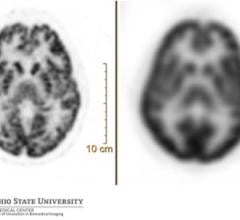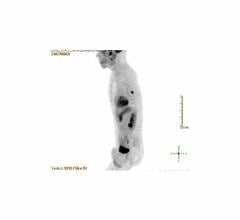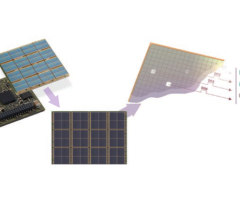March 10, 2010 - To help clinicians communicate about radiation dose exposure during radiological procedures, a new dose ...
PET Imaging
Positron emission tomography (PET) is a nuclear imaging technology (also referred to as molecular imaging) that enables visualization of metabolic processes in the body. The basics of PET imaging is that the technique detects pairs of gamma rays emitted indirectly by a positron-emitting radionuclide (also called radiopharmaceuticals, radionuclides or radiotracer). The tracer is injected into a vein on a biologically active molecule, usually a sugar that is used for cellular energy. PET systems have sensitive detector panels to capture gamma ray emissions from inside the body and use software to plot to triangulate the source of the emissions, creating 3-D computed tomography images of the tracer concentrations within the body.
Linking medical imaging to patient outcomes has long been a struggle for the medical community. But when Columbia ...
The syngo Dynamic PET software with myocardial blood flow is a cardiac imaging application for the Biograph PET/CT ...
Digital technology is opening remarkable opportunities for clinical positron emission tomography (PET) about which ...
February 24, 2010 - The American College of Radiology Task Force on Radiation Dose in Medicine will testify before the ...
February 23, 2010 - The American College of Radiology (ACR) has launched an online nuclear medicine and positron ...
February 19, 2010 – The use of medical technology in the United States increased dramatically between 1996 and 2006 ...
Precision can have an enormous impact on patients. From diagnosis to patient monitoring (see “How Digital PET/CT Can ...
February 12, 2010 - After the U.S. FDA announced it is launching a program designed to reduce unnecessary medical ...
February 9, 2010 - Nuclear medicine and molecular imaging professionals discussed the critical role of molecular imaging ...
February 2, 2010 - Two protocols for reduced-dose cardiac imaging, without compromising image quality, may help enhance ...
PET is getting ready to venture outside oncology, cardiology and mainstream neurology. High on the list of new clinical ...
January 26, 2010 - The need for more control when developing a radiation therapy plan for 4D respiratory is critical ...
January 26, 2010 – The U.S. Department of Energy’s National Nuclear Security Administration (NNSA) selected GE Hitachi ...
January 25, 2010 - Heart failure is a serious medical condition, in which the heart muscle progressively loses its ...
Analog is approximate. Digital is specific. Therein lies the fundamental difference between digital PET and its analog ...
January 20, 2010 - First Coast Oncology in Jacksonville, Fla., employs a technique for whole breast irradiation that is ...
January 13, 2010 - Changes in staffing in the emergency department impact the availability of diagnostic modalities or ...
January 13, 2010 – Research validates the efficacy of the recent reclassification of the T category in the International ...
January 13, 2010 - Compared to computed tomography (CT), mammography and other commonly used tests, positron emission ...
January 6, 2010 - The American College of Nuclear Medicine (ACNM) is holding its annual meeting Jan. 27-28, 2010, in ...
December 29, 2009 - Imaging is at the heart of diagnostic procedures and is the focus of the "ESC Textbook of ...
December 28, 2009 - The Medical College of Wisconsin will license a novel molecular imaging technology designed to ...
January 4, 2010 - Patients demonstrated significant improvements in motor skills and brain function in a large-scale ...


 March 10, 2010
March 10, 2010 

















